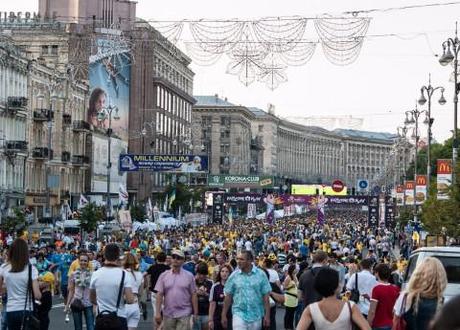 Downtown Kiev, at the height of Euro 2012 madness – minutes before the Ukraine-Sweden match.
Downtown Kiev, at the height of Euro 2012 madness – minutes before the Ukraine-Sweden match.
When Kiev-born writer Mikhail Bulgakov wrote his master work, The Master and Marguerita, more than seven decades ago, he never thought Stalin’s Soviet Union regime would allow the wider public to read it.
Just as Soviet Ukraine never thought it would see the day in which its people and culture would enjoy the freedom of expressing themselves without prejudice or persecution. Today, this vast and diverse country, half the size of Western Europe, thrives. Ages away from what was a somber and isolating period of its history, it now has the opportunity to seize the world’s attention.
“This has to be the best place on Earth, women are gorgeous, people are friendly, there’s plenty of horilka (vodka in Ukrainian) and Spain just won, once again, the European championship. Pinch me because I must be dreaming,” Daniel Ruiz, a 22-year-old Spanish football fan, laughed, right after the final match of the continent’s most important football tournament. Ruiz, like millions of other football fans, was in Kiev this June for the UEFA 2012, which was hosted by Ukraine in conjunction with Poland.
After decades of isolationism and a broken revolution, Ukraine is finally moving into the light – and the decision to award the former Soviet Republic Euro 2012 hosting duties seemed to reward that. And Ukraine didn’t disappoint: Revamped streets, new hotels, longer opening hours for most restaurants and bars, a new airport and specially trained policemen and tourist escorts were all part of the country’s Europe-leaning repositioning strategy. With an ambivalent image in “the West” and a yet to be seen policy vis-à-vis its all mighty neighbor, Russia, Ukraine could not be more eager to be taken seriously.
“Ukraine has had a very abrupt recent history that has kept the country from developing a true identity. After the fall of communism and the nascent arrival of nationalism it has experienced a journey of self-discovery that only recently has begun to show results,” affirmed Aliona Soliemoneva, a historian from Kiev’s National University. Ukraine still has some way to go, with a strong division between its Eastern side, more ethnic Russian and ideologically conservative, and its Western side, more ethnic Ukrainian and ideologically liberal, a very young democracy and plenty of economic challenges. But these challenges are not as great as one might think – just take Kiev.
“Kiev is the perfect example of how much we have evolved, both as a country and as a society. Its cosmopolitan environment and its decisive pace towards the future make two very good cases. I love my city and I’m so happy to be a part of its new and changing face,” declared Natalia Batoueva, a 30-something designer who worked on the city’s rebranding for the Eurocup.
With a centuries-old history, Kiev has been no stranger to important events. It was here that “Mother Russia” emerged, after a couple of monks founded a monastery by the river Dnieper that eventually gave birth to the Orthodox Church embraced by the Czars. But it was also here that the Nazis, unsuccessfully, tried to capture the Soviet Union, taking hundreds of lives in their efforts; and that a brutal famine, orchestrated by Stalin in the 1930s, starved millions. It was also here, some miles to the north that the world stood still when a reactor from Chernobyl’s nuclear plant melted down, causing one of the worst nuclear disasters in history.
Today, Kiev struggles to attain our attention, while still figuring out its own identity. Nothing is more tempting for an eager traveler to go and discover it by himself.

